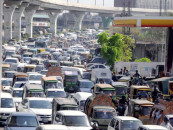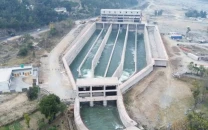Managing urban flooding
We should not undermine the role of weather forecast for urban management system

Ibrar.space@uclmail.net
In rural areas, most of the time, the agriculture sector gets affected along with infrastructure and lives. Over the past few decades, however, the development policy has also changed alongside these events. According to EM-DAT data, the risk of natural disasters in Pakistan has increased over the past 100 years: four per cent (four events) of the global total of natural disasters occurred in the country during 1900-1947, rising to 64 per cent (79 events) during 1948-1990 and 35 per cent (50 events) in 1991-2016.
Over the years, Pakistan has shifted towards industries based on agricultural raw materials and urban economies, especially Karachi, are playing a key role in economic boost. Recently, the city had been the hot topic of discussion in media, the provincial authorities owing to the recent rains, which have put Karachiites in a miserable condition. This rain spell led us to rethink the country’s urban framework for disaster management, if we want to protect the economy and the community.
The first question that arises is whether this rain spell was a natural disaster or not? To understand that there is a need to comprehend the complex system of natural disasters. These can be narrated as (a) extreme events like floods of 2010 and (b) man-made disasters like urban flooding. Extreme events mostly come with a wide spread of spatial impacts, while man-made disasters are the outcome of poor planning and intervention into natural landscape process like levelling the earth for urban structure, leading to fragmentation of natural pathways and dis-connectivity in water drainage surface.
Urban flooding has always been a mistreated chapter in Pakistan, especially in high urban sprawl cities like Karachi. The only solution is being prepared and opting for the best way out. The current monsoon spell wasn’t so intense for it to have resulted in urban flooding. Not only politicians and the local government departments are at fault for it, but instead the whole community. We don’t have a decision support system for either economic sectors, such as agriculture and industry, or disaster management. Besides, there are so many missing links to vital information that we still ignore in our policy and decision-making system. One of the best options is to opt for an effective use of space technology as the core component of any disaster management related activities, along with the best possible integration with ground information.
As an example, I have shared a free available optical satellite data which can provide the vital information related to cloud cover, cloud cover type and cloud with possible rain. This turns out to be very effective in understanding the extent of rain event in the southern part of Sindh, especially in Karachi.
Secondly, we should not undermine the role of weather forecast for urban management system and work towards improving the meteorological stations network. Thirdly, we need to integrate urban development policies with topographic and geospatial sciences. Perhaps we are missing safe rainwater channel diversions and disposal of rain/flash flood water into open but population-free areas. Another doable option is to promote the concept of ‘citizen science’, where each individual can become a scientist by providing raw information required by a decision support system.
Published in The Express Tribune, September 10th, 2017.
Like Opinion & Editorial on Facebook, follow @ETOpEd on Twitter to receive all updates on all our daily pieces.













COMMENTS
Comments are moderated and generally will be posted if they are on-topic and not abusive.
For more information, please see our Comments FAQ